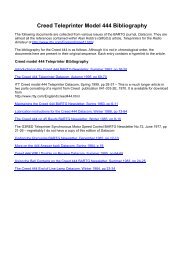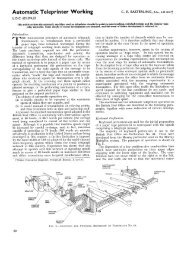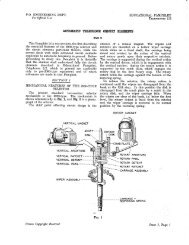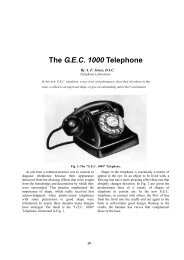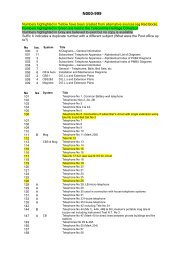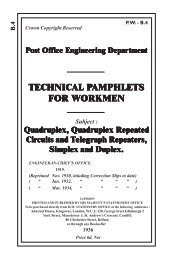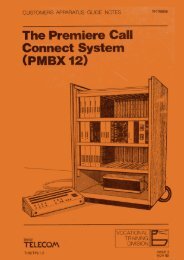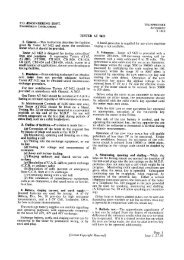TRAFFIC CONTROL TELEPHONE SYSTEMS Circuit - Sam Hallas
TRAFFIC CONTROL TELEPHONE SYSTEMS Circuit - Sam Hallas
TRAFFIC CONTROL TELEPHONE SYSTEMS Circuit - Sam Hallas
You also want an ePaper? Increase the reach of your titles
YUMPU automatically turns print PDFs into web optimized ePapers that Google loves.
Page 14<br />
Superimposed Telegraph <strong>Circuit</strong><br />
A telegraph circuit may be worked over a line used for traffic control telephone<br />
as a phantom circuit. The traffic control circuits divided by a Repeating coil at the<br />
first telegraph station and bridged by coils at subsequent stations. Where it is required<br />
to divide a telegraph circuit at an intermediate station, a Repeating coil is used<br />
in place of the bridging coil. The telegraph arrangements are shown in Fig. 5.<br />
Composite <strong>Circuit</strong>s<br />
Composite circuits including one or more traffic control circuits may be set up<br />
in any of the arrangements used for telegraphy and telephony as long as the components<br />
used allow transmission of the 32 cycle signalling current used for selective<br />
calling.<br />
TESTS ON SELECTIVE APPARATUS<br />
We give below suggestions for testing under two headings, viz.:— periodic tests<br />
and tests on failure of operation.<br />
If the periodic tests are made regularly, this will largely reduce the necessity for<br />
making the other tests.<br />
Periodic Tests<br />
1. Line tests should be made daily, as the line as a rule is subject to extreme<br />
variations due to its exposed condition and interference from outside sources,<br />
also to the variable weather conditions, etc. No attempt will be made here to<br />
indicate the best way to determine the faults in the line such as opens, shorts,<br />
crosses, leaks, etc., as this depends in a great measure on the local conditions<br />
and the testing apparatus available.<br />
2. Test (every two weeks) the potential of the local and main batteries when the<br />
normal operating current is flowing.<br />
3. Test (once a month) by operating each calling key and determine that the time<br />
the positive potential is put to the line is equal to the time that the negative<br />
potential is put to the line for each impulse as described in Parts 1 and 2,<br />
pages 4 and 19. If the results for all keys are the same, the local battery in<br />
good condition and the time that the positive and negative potential is put to<br />
line is not equal, then the potentiometer YD should be adjusted.<br />
If a few keys give unequal results, the K1 and K2 contacts on these keys should<br />
be adjusted to give the same result as the other keys.<br />
4. Test (once a month) the time of one complete operation of each key. The time<br />
should be within the allowable variation for each key given on page 19. If not,<br />
adjust the governor springs as described to make it so. A convenient way to<br />
do this is to make sure that one key is right by timing with a stop watch, if



